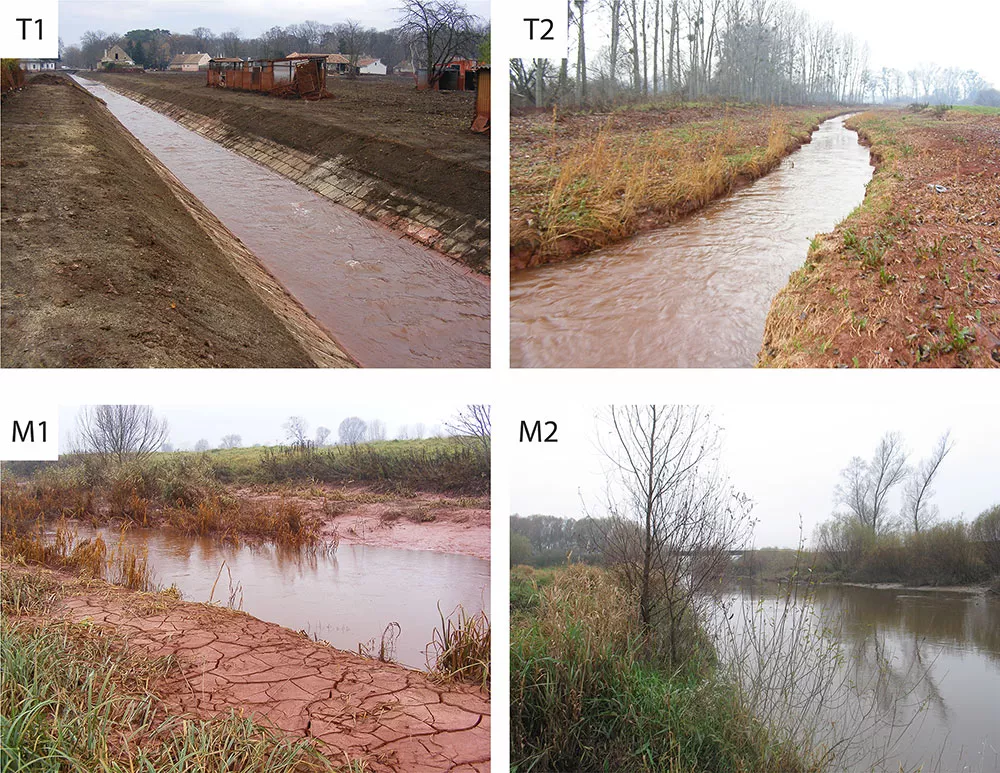A ten-year-long examination of macroinvertebrate community recovery was conducted by Hungarian hydrobiologists following a catastrophic spill of highly alkaline red sludge into lowland streams in 2010 near Ajka, Hungary. The researchers from the HUN-REN Balaton Limnological Research Institute (HUN-REN BLRI), HUN-REN-PE Limnoecology Research Group, HUN-REN Centre for Ecological Research (HUN-REN CER), the University of Pannonia, and the University of Pécs revealed that the severity of the disturbance plays a pivotal role in determining the long-term recovery dynamics of the macroinvertebrate community. They gathered evidence from aquatic ecosystems showing that the more severe the disturbance, the later the macroinvertebrate community reaches an equilibrium state. In their study published in the prestigious journal Science of The Total Environment, they established a theoretical framework enabling the examination of the consequences of large and infrequent disturbances (LID).
Understanding the impact of ecological disturbances on ecosystems and monitoring their recovery process is vital for ecologists. Disturbances of high intensity and severity, known as "large and infrequent disturbances" (LIDs), pose significant challenges as they are often unplanned and complex events. Long-term surveys play a crucial role in comprehending the recovery process by smoothing out variations in communities and explaining subtle changes in community assembly.
However, investigating the true effect of LIDs on aquatic ecosystems over decades is hindered by their scarce occurrence and the absence of a standardised terminology. To address this, the researchers developed a theoretical framework comprising a series of consecutive phases like Ramp-up, Overshoot, and Oscillation phases to evaluate community recovery dynamics post-LID.
In 2010, Hungary faced a massive LID when a dam containing red sludge (pH >13) collapsed, causing the largest environmental disaster in Central Europe. A decade-long study examined the recovery of macroinvertebrate communities following this event, comparing recovery patterns after coarse- and fine-grain disturbances. Coarse-grain disturbances can cause the extinction of all organisms, while after a fine-grain disturbance, the community was able to partially survive.

Photos from the examined stream sections from November 2010
T1: The section of the Torna-stream closest to the pollution. The picture was taken after the cleaning of the riverbed, the gully and the surrounding areas, as the remaining red sludge in this area was about 50-100 cm high. T2: Torna-stream further away from the pollution. In this section only the lower parts of the bank was cleaned up. M1: River Marcal after the Torna-stream inlet. This section was cleaned after the picture was taken. M2: The section of the River Marcal furthest from the pollution. In this section, there was no sedimentation on the bank, and a thin coating of sediment had formed in the bed and on the vegetation.
(Credit: Kata Karádi-Kovács)
“Our data shows that within a decade, the community recovered successfully both taxonomically and functionally after both coarse- and fine-grain disturbances. We found that the severity of the disturbance plays a pivotal role in determining the long-term recovery dynamics. This implies that the dynamics of recovery vary when the LID totally or partially diminishes the fauna. Specifically, recovery appears gradual after coarse-grain disturbances, while it tends toward an asymptotic pattern following fine-grain disturbances,” said Pál Boda, leader of the HUN-REN CER Aquatic Macroinvertebrate Research Group, and one of the lead authors of the study.
The study demonstrated that the initial recovery phase was steep and persisted for 4-9 months, irrespective of the severity of disturbances. The coarse-grain disturbances caused a temporary swing of all community metrics compared to the final equilibrium values, a phenomenon the researcher refer to as 'Overshoot’. In contrast, such a remarkable overshoot could not be observed in communities affected by fine-grain disturbances. “The more severe the disturbance, the later the macroinvertebrate community reaches an equilibrium state,” the researcher explained.
The study emphasises the need for recovery surveys to span 2.5-3 years to capture the entire recovery process, irrespective of disturbance severity. These findings contribute to our understanding of ecosystem resilience and aid in the development of effective conservation strategies.
The study demonstrates the effective utilisation of research synergies through collaborative efforts among researchers from various institutions, including the University of Pannonia, University of Pécs, HUN-REN BLRI, the HUN-REN-PE Limnoecology Research Group, and HUN-REN CER, as highlighted by Pál Boda.
Publication:
Kata Karádi-Kovács, Ildikó Szivák, Tamás Bozóki, Krisztián Kovács, Arnold Móra, Judit Padisák, Géza Balázs Selmeczy, Dénes Schmera, Pál Boda: Long-term recovery dynamics determined by the degree of the disturbance – Ten years tracking of aquatic macroinvertebrate recolonisation after an industrial disaster (Red Sludge Disaster, Hungary), Science of The Total Environment, Volume 921, 2024,171071, ISSN 0048-9697, DOI: 10.1016/j.scitotenv.2024.171071.